Cities With the Most Job Gains and Losses in 2021
Published on: 12/13/2021
Since the short pandemic-induced recession of 2020, the job market has recovered quickly. At the onset of the pandemic, the U.S. lost over 22 million jobs, but according to the most recent data from the Bureau of Labor Statistics, nonfarm employment is currently just 4.2 million lower than pre-pandemic levels. While monthly job gains have not been steady, employment in October of 2021 was 5.8 million (4.1%) higher than a year ago.
Compared to the Great Recession precipitated by the collapse of the housing market in 2008, the economic contraction resulting from COVID-19 was both shorter and more severe. During the Great Recession, nonfarm employment fell by nearly 6% and the unemployment rate rose from 5% to 10%, which at that point was the highest rate since 1983. It took nearly seven years for these top-level job metrics to fully recover.
The official COVID-19 recession, on the other hand, lasted just two months, making it the shortest downturn on record, but also one of the deepest. In just two months, the unemployment rate rose from 3.5% to 14.8% and total employment dropped from 152 million to 130 million (or approximately 14.5%). Today, less than two years after the start of the pandemic, total employment is just 2.8% below the pre-pandemic peak.
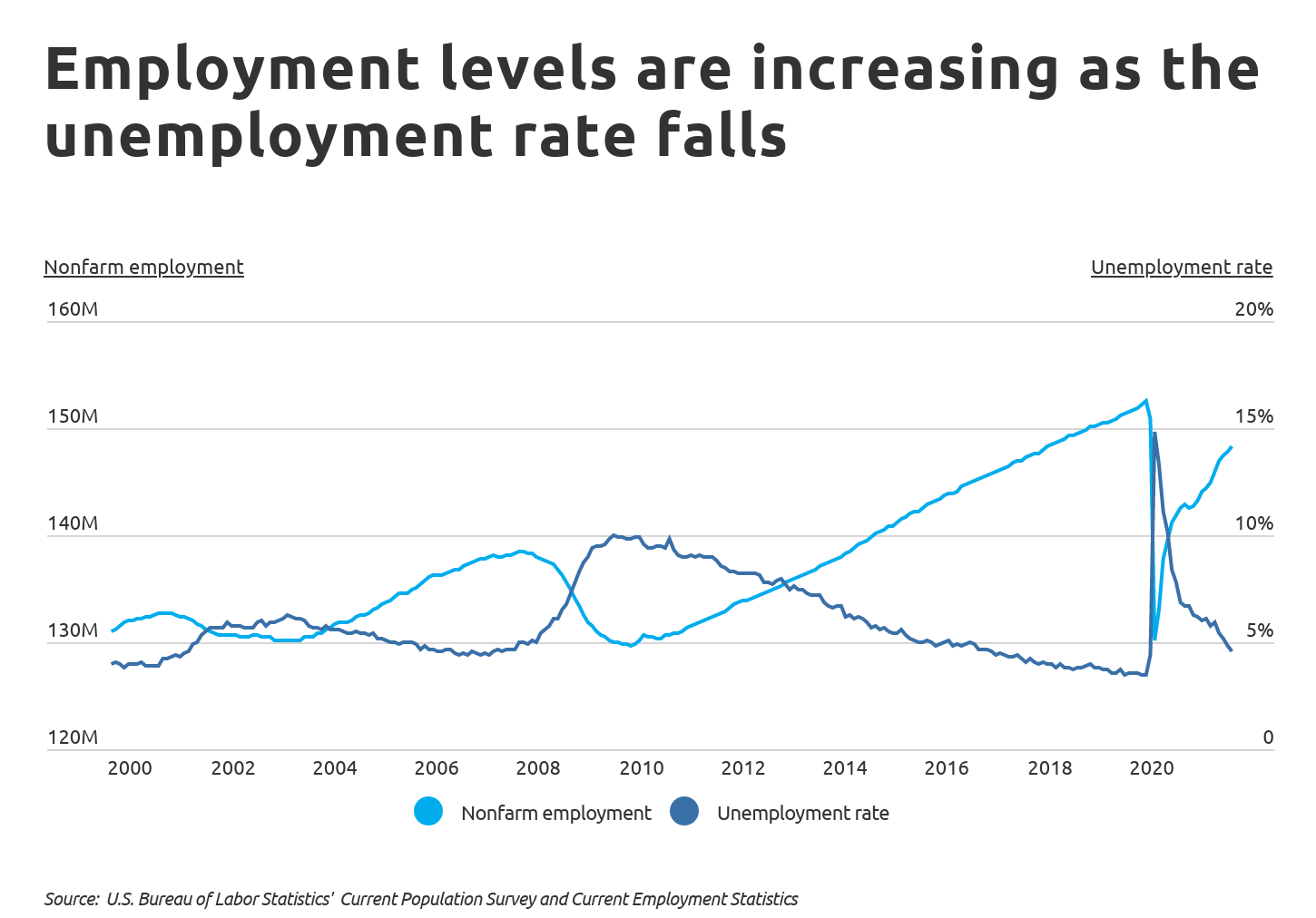
The COVID-19 pandemic impacted some industries—especially those dependent on face-to-face interactions—far more than others. However, over the past year, every sector except utilities gained jobs back. Leisure and hospitality, one of the hardest hit during the pandemic, added the most jobs between October 2020 and 2021. After shedding nearly 50% of its workforce at the start of the pandemic, the sector grew more than 14% in 2021, adding nearly 2 million jobs. Other sectors that added the most jobs in 2021 include professional and business services, education and health, and transportation and warehousing.
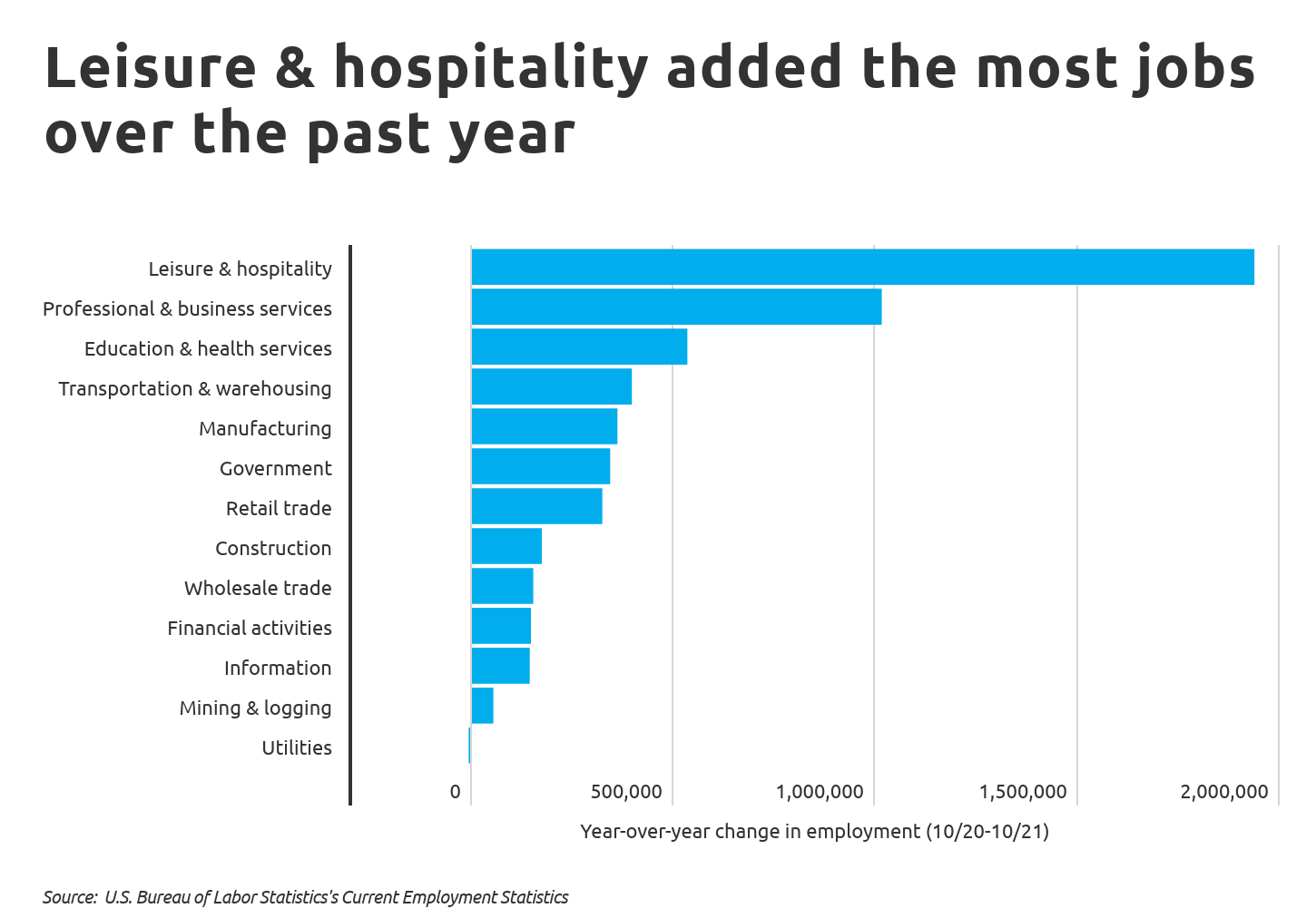
On a regional level, the West Coast experienced the largest employment gains over the past year. Hawaii, whose tourism-dependent economy was disproportionately hurt by the pandemic, leads the country in job gains from October 2020 to October 2021 with a 10.5% increase in nonfarm employment. However, total nonfarm employment in the state is still 12.9% below pre-pandemic levels. Similarly, Nevada—which is also highly dependent on tourism—increased its employment by 7.6% from a year ago and remains about 5.5% below its pre-pandemic peak.

TRENDING
Good credit plays a vital role in your financial life. If you're new to credit and need to establish it from scratch, check out our comprehensive guide on how to build credit.
To find the metropolitan areas with the most job gains in 2021, researchers at Self Financial analyzed the latest employment data from the U.S. Bureau of Labor Statistics. The researchers ranked metro areas according to the percentage change in employment from October 2020 to October 2021. Researchers also included the total change in employment, total employment, and the unemployment rate.
To improve relevance, only metropolitan areas with at least 100,000 people were included in the analysis. Here are the U.S. metros with the most job gains in 2021.
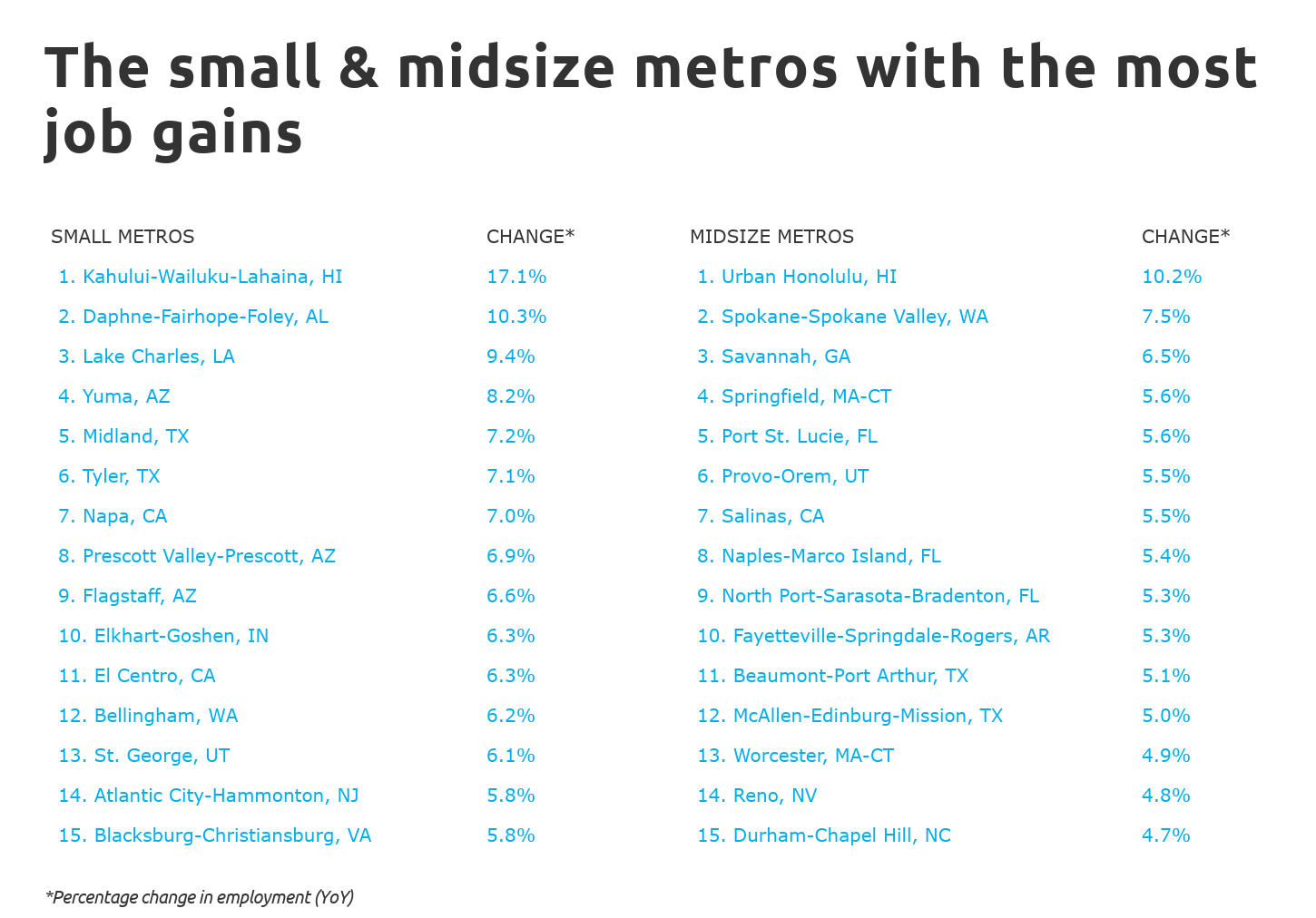

Photo Credit: Sean Pavone / Shutterstock
RELATED
Most people know you need good credit for obvious reasons like getting a credit card, car loan or mortgage. But credit can play a role in less obvious things like renting a car, apartment or home, or getting approved for a cell phone contract. But can you be denied a job because of bad credit?

Photo Credit: Farid Sani / Shutterstock

Photo Credit: Luciano Mortula - LGM / Shutterstock

Photo Credit: Sundry Photography / Shutterstock

Photo Credit: Bob Pool / Shutterstock

Photo Credit: photo.ua / Shutterstock

Photo Credit: Wirestock Creators / Shutterstock

Photo Credit: Bonnie Fink / Shutterstock

Photo Credit: Chones / Shutterstock

Photo Credit: ESB Professional / Shutterstock

Photo Credit: Checubus / Shutterstock
TRENDING
Over time, using a secured credit card will boost your length of credit history, which makes up 15% of your FICO credit score. Here’s more on how a secured credit card can help you build credit.

Photo Credit: Gregory E. Clifford / Shutterstock

Photo Credit: Roschetzky Photography / Shutterstock
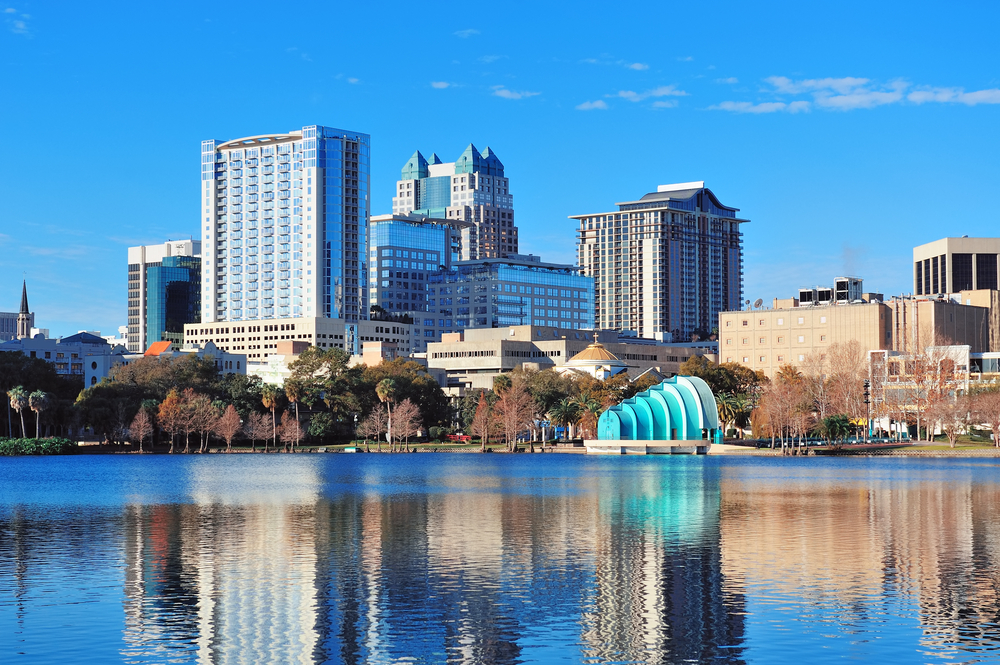
Photo Credit: Songquan Deng / Shutterstock
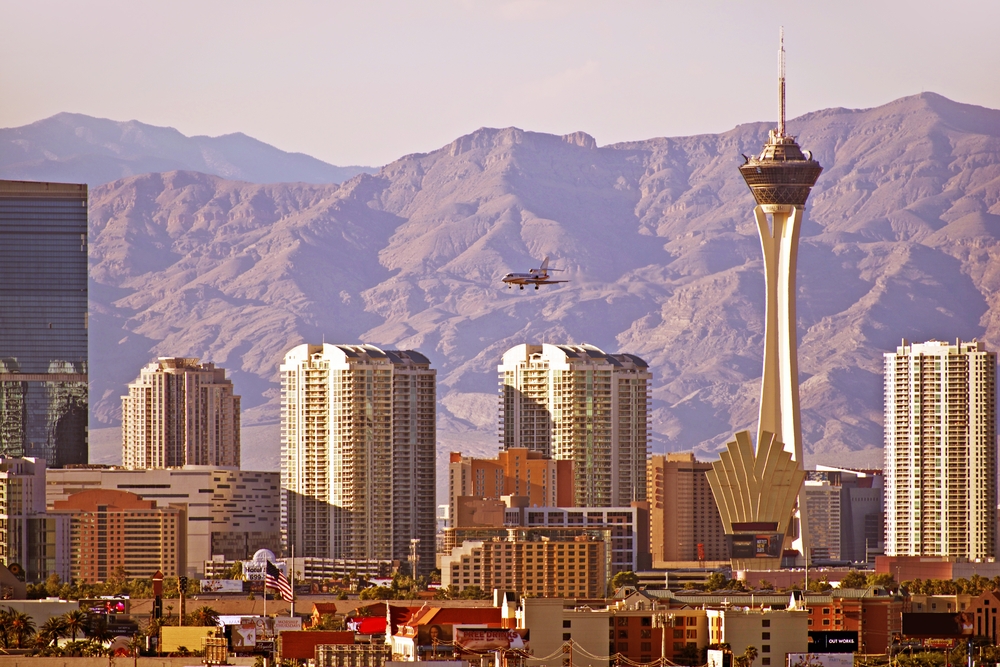
Photo Credit: Virrage Images / Shutterstock
To improve relevance, only metropolitan areas with at least 100,000 people were included in the analysis. Additionally, metro areas were grouped into the following cohorts based on population size:
Compared to the Great Recession precipitated by the collapse of the housing market in 2008, the economic contraction resulting from COVID-19 was both shorter and more severe. During the Great Recession, nonfarm employment fell by nearly 6% and the unemployment rate rose from 5% to 10%, which at that point was the highest rate since 1983. It took nearly seven years for these top-level job metrics to fully recover.
The official COVID-19 recession, on the other hand, lasted just two months, making it the shortest downturn on record, but also one of the deepest. In just two months, the unemployment rate rose from 3.5% to 14.8% and total employment dropped from 152 million to 130 million (or approximately 14.5%). Today, less than two years after the start of the pandemic, total employment is just 2.8% below the pre-pandemic peak.

The COVID-19 pandemic impacted some industries—especially those dependent on face-to-face interactions—far more than others. However, over the past year, every sector except utilities gained jobs back. Leisure and hospitality, one of the hardest hit during the pandemic, added the most jobs between October 2020 and 2021. After shedding nearly 50% of its workforce at the start of the pandemic, the sector grew more than 14% in 2021, adding nearly 2 million jobs. Other sectors that added the most jobs in 2021 include professional and business services, education and health, and transportation and warehousing.

On a regional level, the West Coast experienced the largest employment gains over the past year. Hawaii, whose tourism-dependent economy was disproportionately hurt by the pandemic, leads the country in job gains from October 2020 to October 2021 with a 10.5% increase in nonfarm employment. However, total nonfarm employment in the state is still 12.9% below pre-pandemic levels. Similarly, Nevada—which is also highly dependent on tourism—increased its employment by 7.6% from a year ago and remains about 5.5% below its pre-pandemic peak.

TRENDING
Good credit plays a vital role in your financial life. If you're new to credit and need to establish it from scratch, check out our comprehensive guide on how to build credit.
To find the metropolitan areas with the most job gains in 2021, researchers at Self Financial analyzed the latest employment data from the U.S. Bureau of Labor Statistics. The researchers ranked metro areas according to the percentage change in employment from October 2020 to October 2021. Researchers also included the total change in employment, total employment, and the unemployment rate.
To improve relevance, only metropolitan areas with at least 100,000 people were included in the analysis. Here are the U.S. metros with the most job gains in 2021.

Large Metros With the Most Job Gains

Photo Credit: Sean Pavone / Shutterstock
15. Miami-Fort Lauderdale-Pompano Beach, FL
- Percentage change in employment (YoY): +4.7%
- Total change in employment (YoY): +118,800
- Total employment (October 2021): 2,641,000
- Unemployment rate (October 2021): 4.0%
RELATED
Most people know you need good credit for obvious reasons like getting a credit card, car loan or mortgage. But credit can play a role in less obvious things like renting a car, apartment or home, or getting approved for a cell phone contract. But can you be denied a job because of bad credit?

Photo Credit: Farid Sani / Shutterstock
14. Raleigh-Cary, NC
- Percentage change in employment (YoY): +4.8%
- Total change in employment (YoY): +30,000
- Total employment (October 2021): 657,200
- Unemployment rate (October 2021): 3.0%

Photo Credit: Luciano Mortula - LGM / Shutterstock
13. Atlanta-Sandy Springs-Alpharetta, GA
- Percentage change in employment (YoY): +4.8%
- Total change in employment (YoY): +129,500
- Total employment (October 2021): 2,823,800
- Unemployment rate (October 2021): 2.4%

Photo Credit: Sundry Photography / Shutterstock
12. San Jose-Sunnyvale-Santa Clara, CA
- Percentage change in employment (YoY): +4.9%
- Total change in employment (YoY): +52,100
- Total employment (October 2021): 1,114,400
- Unemployment rate (October 2021): 3.8%

Photo Credit: Bob Pool / Shutterstock
11. Portland-Vancouver-Hillsboro, OR-WA
- Percentage change in employment (YoY): +5.0%
- Total change in employment (YoY): +57,100
- Total employment (October 2021): 1,192,900
- Unemployment rate (October 2021): 3.4%

Photo Credit: photo.ua / Shutterstock
10. Salt Lake City, UT
- Percentage change in employment (YoY): +5.2%
- Total change in employment (YoY): +38,600
- Total employment (October 2021): 780,300
- Unemployment rate (October 2021): 1.4%

Photo Credit: Wirestock Creators / Shutterstock
9. Rochester, NY
- Percentage change in employment (YoY): +5.4%
- Total change in employment (YoY): +26,400
- Total employment (October 2021): 516,200
- Unemployment rate (October 2021): 4.2%

Photo Credit: Bonnie Fink / Shutterstock
8. Tampa-St. Petersburg-Clearwater, FL
- Percentage change in employment (YoY): +5.4%
- Total change in employment (YoY): +73,300
- Total employment (October 2021): 1,419,200
- Unemployment rate (October 2021): 3.8%

Photo Credit: Chones / Shutterstock
7. Los Angeles-Long Beach-Anaheim, CA
- Percentage change in employment (YoY): +5.4%
- Total change in employment (YoY): +300,100
- Total employment (October 2021): 5,884,100
- Unemployment rate (October 2021): 7.1%

Photo Credit: ESB Professional / Shutterstock
6. Boston-Cambridge-Newton, MA-NH
- Percentage change in employment (YoY): +5.5%
- Total change in employment (YoY): +140,500
- Total employment (October 2021): 2,693,700
- Unemployment rate (October 2021): 4.7%

Photo Credit: Checubus / Shutterstock
5. Seattle-Tacoma-Bellevue, WA
- Percentage change in employment (YoY): +5.6%
- Total change in employment (YoY): +109,400
- Total employment (October 2021): 2,062,500
- Unemployment rate (October 2021): 4.6%
TRENDING
Over time, using a secured credit card will boost your length of credit history, which makes up 15% of your FICO credit score. Here’s more on how a secured credit card can help you build credit.

Photo Credit: Gregory E. Clifford / Shutterstock
4. Phoenix-Mesa-Chandler, AZ
- Percentage change in employment (YoY): +5.6%
- Total change in employment (YoY): +118,700
- Total employment (October 2021): 2,239,600
- Unemployment rate (October 2021): 3.2%

Photo Credit: Roschetzky Photography / Shutterstock
3. Austin-Round Rock-Georgetown, TX
- Percentage change in employment (YoY): +6.7%
- Total change in employment (YoY): +73,700
- Total employment (October 2021): 1,169,400
- Unemployment rate (October 2021): 3.4%

Photo Credit: Songquan Deng / Shutterstock
2. Orlando-Kissimmee-Sanford, FL
- Percentage change in employment (YoY): +6.7%
- Total change in employment (YoY): +78,300
- Total employment (October 2021): 1,253,800
- Unemployment rate (October 2021): 4.4%

Photo Credit: Virrage Images / Shutterstock
1. Las Vegas-Henderson-Paradise, NV
- Percentage change in employment (YoY): +8.5%
- Total change in employment (YoY): +76,700
- Total employment (October 2021): 975,100
- Unemployment rate (October 2021): 6.6%
Detailed Findings & Methodology
To find the metropolitan areas with the most job gains and losses, researchers at Self Financial analyzed the latest employment data from the U.S. Bureau of Labor Statistics’s Current Employment Statistics and Local Area Unemployment Statistics. The researchers ranked metro areas according to the percentage change in employment from October 2020 to October 2021. In the event of a tie, the metro with the higher employment for October 2021 was ranked higher. Researchers also calculated the total change in employment and the unemployment rate (October 2021).To improve relevance, only metropolitan areas with at least 100,000 people were included in the analysis. Additionally, metro areas were grouped into the following cohorts based on population size:
- Small metros: 100,000–349,999
- Midsize metros: 350,000–999,999
- Large metros: 1,000,000 or more

Written on December 13, 2021
Self is a venture-backed startup that helps people build credit and savings.
Self does not provide financial advice. The content on this page provides general consumer information and is not intended for legal, financial, or regulatory guidance. The content presented does not reflect the view of the Issuing Banks. Although this information may include references to third-party resources or content, Self does not endorse or guarantee the accuracy of this third-party information. Any Self product links are advertisements for Self products. Please consider the date of publishing for Self’s original content and any affiliated content to best understand their contexts.